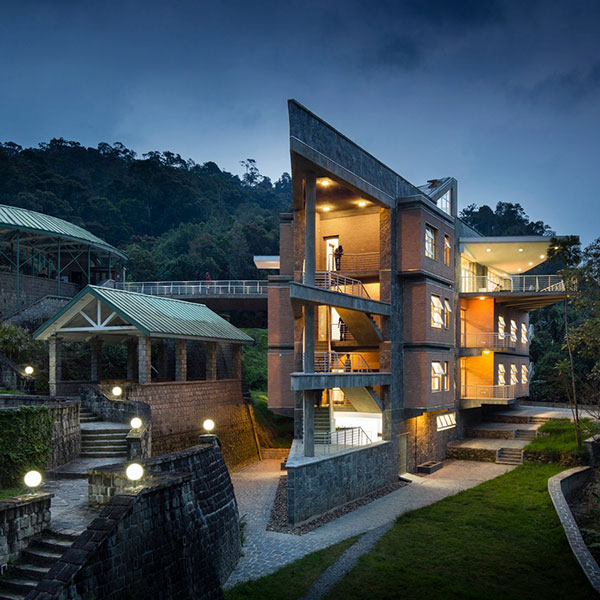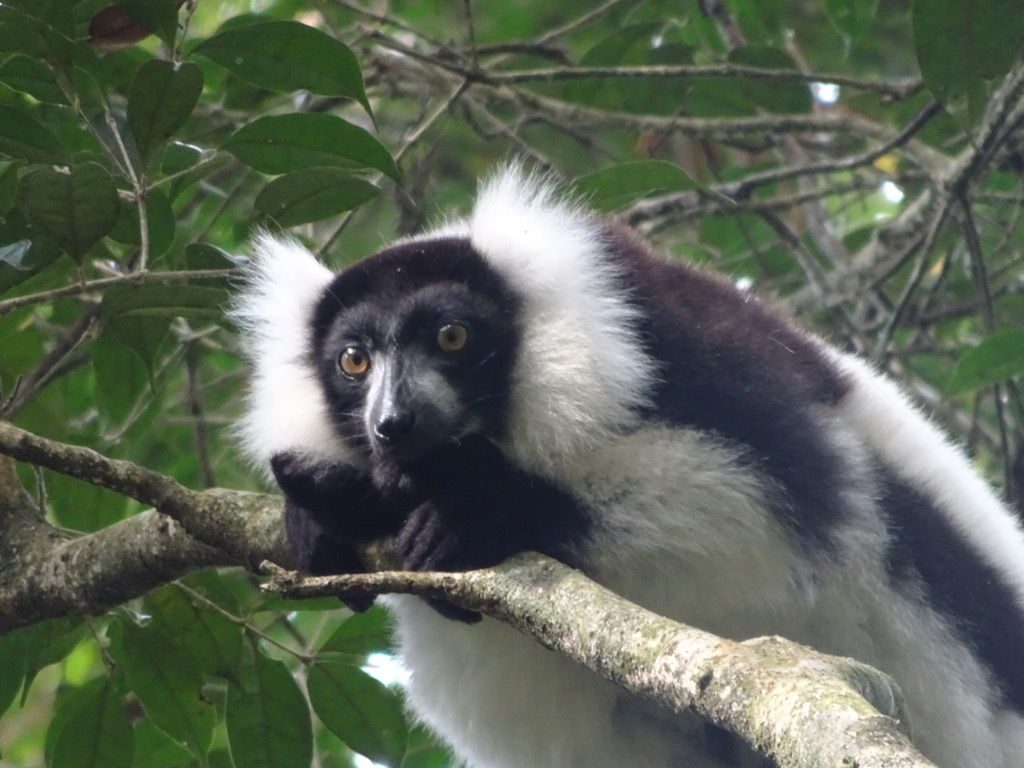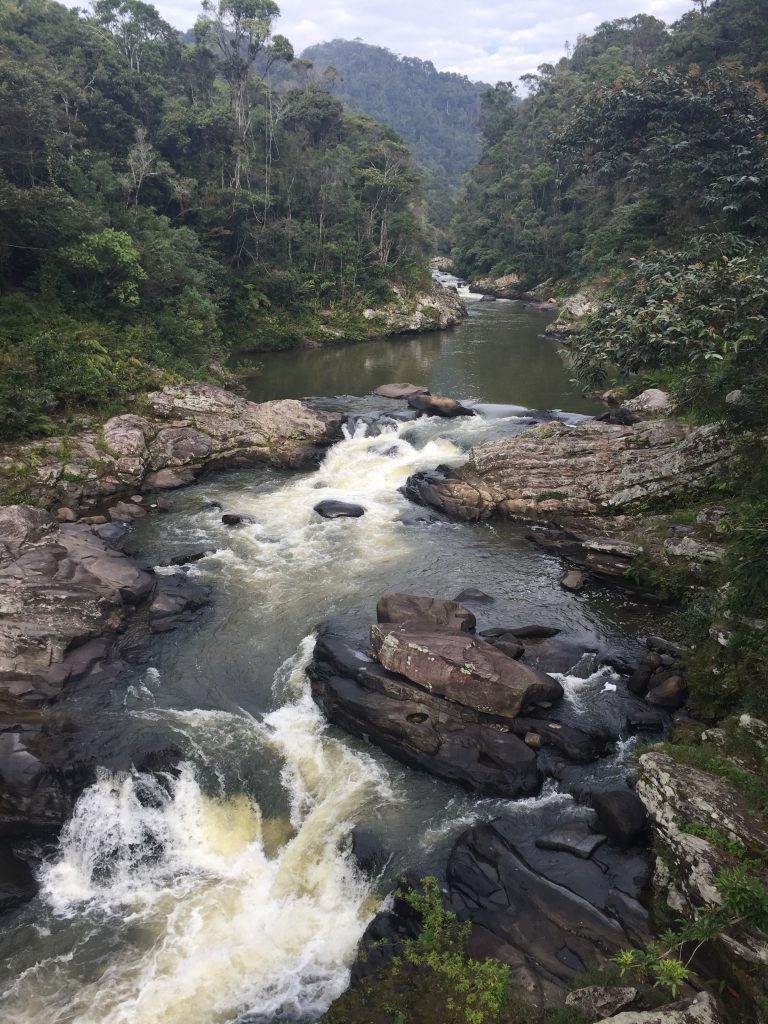 Visiting Centre ValBio
Visiting Centre ValBio
Centre ValBio is located adjacent to Ranomafana National Park in the southeastern part of Madagascar. The park consists of tropical rainforest that lies approximately 90 kilometers west of the Indian Ocean on the east-facing escarpment of Madagascar’s central high plateau.
Madagascar’s capital city, Antananarivo, has a major international airport. Upon arrival in Antananarivo, researchers and visitors coordinate with Stony Brook University's Institute for the Conservation of Tropical Environments’ (ICTE) in-country office, MICET. MICET arranges travel by car to Centre ValBio, which is located 400 kilometers (an 10-hour drive) southeast of the national capital of Antananarivo. A charter flight may also be arranged from Antananarivo to a small airport near Fianarantsoa, the provincial capital, which is 60 kilometers (a one-hour drive) from Ranomafana National Park (RNP).
Major shopping for special supplies and banking is recommended in either Antananarivo or Fianarantsoa since, while the quaint village of Ranomafana is developing quickly, these services are currently unavailable.
Centre ValBio’s campus is located just 7 kilometers west of Ranomafana Village. There you will find a post office, the local market and stores, Madagascar National Parks main office, governmental offices and many other attractions (see below.). Getting between CVB and Ranomafana is about an hour walk or 15-minute car ride. Local transportation can be arranged through Centre ValBio’s Logistics Department.
Centre ValBio's NamaBe Hall, inaugurated in 2014, provides dormitory style accommodations for researchers, students and visitors. Alternatively, a range of accommodation are available (from camping to high-end hotels) between the park entrance and Ranomafana village. Please contact CVB if you would like further information regarding lodging options and availability. We recommend that you make reservations in advance during the high tourist season (September–December).
For researchers, students and volunteers, arrangements can be made in advance through
ICTE and Centre ValBio to accommodate any specific or special needs during your stay
(see also For Researchers section). For scientific tourists and visitors, guided tours and visits to Centre
ValBio's campus, green center in town and projects are available. Group visits can
be arranged in advance and include PowerPoint presentations on CVB's work in addition
to guided tours or hands-on school or village visits. Please contact Centre ValBio
to arrange a tour in advance by e-mail (info@valb.io) or by phone when in-country, 034 135 8171 or 033 027 5398.
Communication
Ranomafana has shown a great development in communication in the last few years including
internet. phone and mail services.
Internet: Centre ValBio is equip with Starlink High-Speed Internet connection.
The Internet cafe or “Tele Centre” is located just bef'sore the post office in the village of Ranomafana. The telecentre is open from 8:00-18:00 at least 6 days a week (Monday – Saturday) and closed on Sunday except during the high season (14:00-18:00 from September – December).
Phone: Three different carriers (Telma, Air Tel and Orange) provide mobile services that work extremely well within Ranomafana and its surrounding area and recharge cards are readily available. Note: Please consult CVB staff for which provider may be best for your work plans (e.g., Telma service works best within the research center, Air Tel at Valohoaka, Orange is cheapest for international calls to the U.S., etc.). You can purchase a cell phone and phone recharge cards at the telecenter or in various other shops and kiosks in Ranomafana.
Mail: The post office in Ranomafana is open 5 days a week (Monday through Friday) and closed
on the weekends (Saturday and Sunday). CVB checks our mailbox daily and deposits any
mail in the ‘Researcher’ or ‘Study Abroad’ (the latter for training groups) boxes
in the hallway of the administrative level at CVB. Large packages (that usually require
a small fee) are sent to Fianarantsoa and slips are provided to alert you of their
arrival. You can arrange with the CVB staff for pick up when one of the vehicles makes
a supply run to Fianarantsoa (often once weekly during the high season).
Health concerns
It is highly recommended that all visitors to CVB have International Travel Insurance
that covers medical evacutions. Centre ValBio has a basic “First Aid Kit” that can be used in case of an emergency,
including some basic medication such as anti-diuretic, anti -inflammatory medicine,
pain killers, and basic treatment of small cuts (bandages, alcohol, etc.). CVB has
a health team that can assist with care. In case an illness or injury is more serious,
outside health professionals and medical doctors can also be contacted and are located
in Ranomafana village, Fianarantsoa and Antananarivo depending on your needs. CVB
and MICET are ready to assist you, accompany you and provide a vehicle if an emergency
trip is needed at any hour. It is highly recommended to bring malaria prophylactic,
paracetamol/ibuprofen, cipro, flagyl, allergy medication, anti-gas over the counter
medicine and a basic first-aid kit with you from your home country. Basic pharmacies
are available in Ranomafana and most medicine is readily available in larger cities
(Antananarivo and Fianarantsoa). In case of any medical emergency or natural disaster,
our staff will be sure to inform any researchers or students on how to proceed. CVB,
MICET and ICTE/Stony Brook University have an emergency evacuation protocol in order
and are ready to assist in case immediate evacuation from Madagascar is needed for
any reason.
Money
Malagasy Currency & Conversion Rates: The Malagasy currency is in Malagasy Ariary (MGA). $1 equals approximately 4500 MGA
depending on the day's exchange rate. Please consult any exchange rate website as
the fluctuate daily.
Exchanging Money & ATM Withdrawals: We recommend that short-term visitors bring or exchange money at the airport upon arrival in Antananarivo. Please note that only bills dated after 2017 will be accepted to change. Longer-termed researchers and students can wire money to the CVB account in advance (funds will made available upon your arrival). However, if you need to exchange foreign money during your stay, you will need to go to Fianarantsoa, where the nearest banks are located (e.g., BFV, BMOI, and BNI). Only VISA credit cards are accepted in Madagascar.
Climate/Weather Ranomafana National Park (RNP) is located in the eastern, moist, forest climate and
is hot and subtropical for much of the year. November through March is considered
to be the rainy season. Although the dry season extends from April to November, the
northeast and central eastern regions have no months (or weeks) that are completely
without rain. It can be cold in RNP from April through November, so bring a fleece
and long johns if you are coming during that time period. Torrential rain and cyclones
can occur in January, February and March. Annual rainfall ranges from 1500-4000 mm
of rain.Thus, raingear is essential in the forest, especially during the rainy season.
Ranomafana National Park (RNP) is located in the eastern, moist, forest climate and
is hot and subtropical for much of the year. November through March is considered
to be the rainy season. Although the dry season extends from April to November, the
northeast and central eastern regions have no months (or weeks) that are completely
without rain. It can be cold in RNP from April through November, so bring a fleece
and long johns if you are coming during that time period. Torrential rain and cyclones
can occur in January, February and March. Annual rainfall ranges from 1500-4000 mm
of rain.Thus, raingear is essential in the forest, especially during the rainy season.
- Note that the humidity is very high in this area, so make sure that your field materials and equipment (such as cameras, binoculars, etc.) are protected or waterproof. Some people have found storing equipment with silica (which is not readily available in Madagascar) helps ensure the shelf life of equipment in humid environments. Planning fieldwork and expeditions may sometimes depend on the weather conditions. You can get information on local weather (temperature and precipitation) through the logistics department. The ‘Tele Centre’ or Internet cafe in the village of Ranomafana can also be useful to check out the regional/national weather.
Ranomafana National Park and Surrounding Villages
Centre ValBio urges you to utilize your time in Madagascar to gain a full experience-exploring both local biodiversity and culture. With this in mind, we would like to give you a brief introduction to the villages and the areas surrounding Ranomafana National Park. Centre ValBio’s education department can assist you in providing information on the people, culture, biodiversity, conservation, and education.
Ranomafana National Park
Centre ValBio is located 500 meters from the entrance to Ranomafana National Park
(RNP). RNP is one of the World Heritage Sites in Madagascar. Not only will you enjoy
the amazing biodiversity of Madagascar’s southeastern rainforest, but you will also
experience the freshness and calm of the forest. This rainforest, run by the Madagascar
National Parks system, contains an incredible and unique variety of flora and fauna.
Tourist and research trails have been made to facilitate hiking and walking in the
forest. The most visited areas of the park include the waterfall, old village sites,
historical monuments, Bellevue (overlook), old trails and tombs. While hiking through
the forest and along streams, you can also learn about traditional beliefs and cultures.
Note that you must hire or be with a guide to hike in the forest. CVB staff can arrange
a MNP approved guide for your hike.
Around Ranomafana
The name ‘Ranomafana’ (hot water) came from the presence of a hot spring. In Ranomafana
village, thermal baths and a communal swimming pool is open to the public for a small
entrance fee to relax and/or to get health treatments.
 The mixed culture of Antanala and Betsileo increases the cultural richness of Ranomafana.
The “Antanala” (the forest people) cannot live without the forest; and the Betsileo
are the best rice growers in Madagascar. Villagers continue to practice different
kinds of traditional ceremonial and religious rituals during family events. You can
experience traditional culture, dance, and local music by inviting local musicians
and dancers or arranging a performance by local artists. These groups can perform
shows upon request using traditional instruments, song and dance. A small contribution
is greatly appreciated.
The mixed culture of Antanala and Betsileo increases the cultural richness of Ranomafana.
The “Antanala” (the forest people) cannot live without the forest; and the Betsileo
are the best rice growers in Madagascar. Villagers continue to practice different
kinds of traditional ceremonial and religious rituals during family events. You can
experience traditional culture, dance, and local music by inviting local musicians
and dancers or arranging a performance by local artists. These groups can perform
shows upon request using traditional instruments, song and dance. A small contribution
is greatly appreciated.
In Ranomafana village, you can find several markets that sell local products, such as fresh fruits, vegetables, and local handcrafts. Sunday is the market day in Ranomafana village and usually runs from 8:30-15:00, where many people from the surrounding rural villages usually come to socialize and sell their products. Remember, you may discuss or negotiate the prices on some local products! After the opening of an artisanal market in 2011, local handicrafts and many other souvenirs are readily available for purchase. A local women’s group (FAMIOVA) located in the old museum, produces high-quality handmade scarves. This woman’s group will produce scarves given your specific preferences (material, style, color, etc.) upon request – so place your orders early! Hand-woven baskets are available from another women’s association (MAEVA) from Sahavendronina (western part of the park) and unique embroidered items and natural food products (peanut butter, juice and honey) are available from Soa Fianarana Association based at Le Palmarie hotel in Ranomafana village. Handmade stuffed lemurs, frogs and chameleons can be purchased at the small store near Kianja Maitso and special orders can be made for your favorite lemur if not available on the spot!
There are also several project demonstration sites to be seen in and near Ranomafana. For example, you can enjoy visiting the medicinal plantation (Mahatsarabe), located three kilometers past Ranomafana center following the national road east. This site is run by an Association of local traditional healers and kings (Ampanjaka) and supported by Centre ValBio. Just before Mahatsarabe is the arboretum, a demonstration site of saplings planted over 20 years ago on degraded lands. There is also Centre ValBio’s demonstration site at Kianja Maitso where you can see our endemic and fruit tree nurseries and learn, for example, about some of our project techniques such as vegetable gardening and composting. There is also the “KajaAla” station at Kianja Maitso, an educational area run jointly by Centre ValBio and Madagascar National Parks, where news and information about Ranomafana National Park and conservation activities are also available.
Additional excursions to local waterfalls, bat caves, as well as canoeing adventures are also available locally. Centre ValBio can also provide recommendations on further exploration east and west of Ranomafana.
